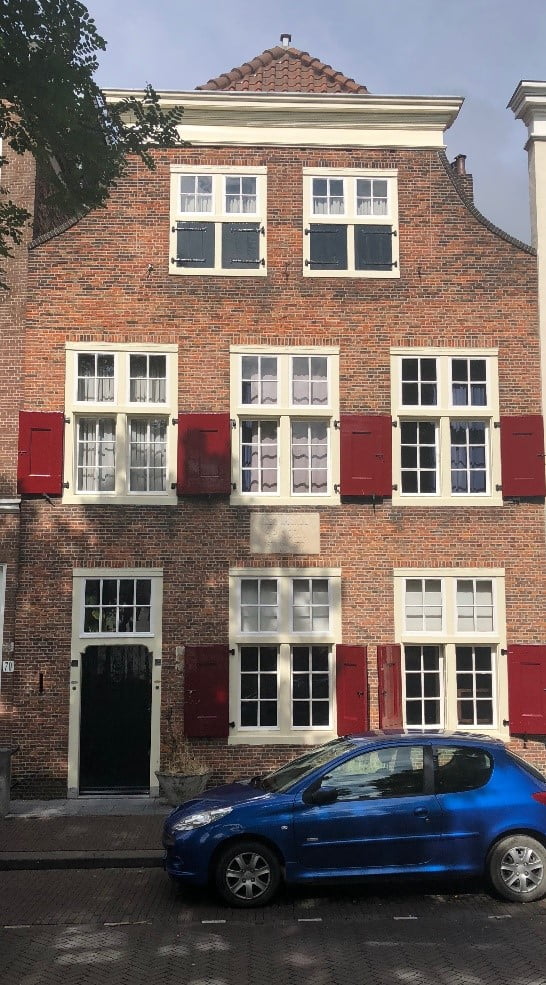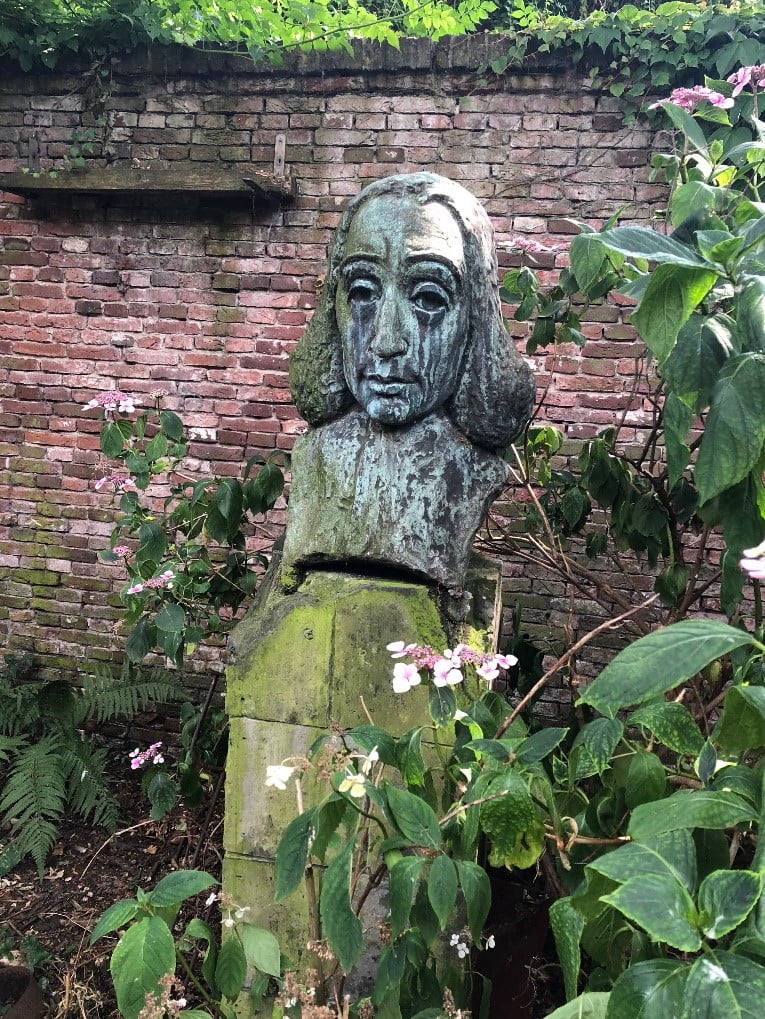Welcome to the virtual walk, click on an icon on the map or scroll down the page to get an explanation.
Use arrow under image to go back to map, click on image to enlarge.
Domus Spinozana
Benedictus de Spinoza was born on 24th November 1632. He lived in the attic of this house during the last seven years of his life. He died here on 22nd February 1677, aged 44 years old.
The house was built in 1646 by Jan van Goyen. A well-known landscape painter of the time, Van Goyen owned several other properties in the neighbourhood. Some years later the house was inhabited by Joannis Havickszoon Steen, better known as Jan Steen (1626-1676) and his wife, Margaretha or Grietje, the daughter of Jan van Goyen. In 1699 Henrick van der Spyck bought the house and in 1671 he became Spinoza’s landlord.In this house Spinoza completed, but did not publish, his text, Ethics. Here he received Leibnitz and it is here in 1672 that he began writing the Tractatus Politicus.
After Spinoza’s death, Van der Spyck made sure that his texts and letters, among them the Ethics, were sent for printing to Jan Rieuwertz in Amsterdam as Spinoza had requested.
Domus Spinoza Reading Room
Although the interior of the reading room is not original, it
captures the atmosphere of 17th century Netherlands.
The bookcases contain approximately 1200 books about Spinoza, as well as an impressive number of translations of his work into more than 20 languages, including Russian, Korean, Chinese and Japanese.
The reading room is meant for scholars, students and visitors who wish to read or consult a book within its walls. It is not possible to borrow books from the library.
The reading room is also used for board meetings and other Spinoza gatherings.
The Statue of Spinoza
The statue of Spinoza was to be inaugurated in 1877, 200 years after the death of Spinoza but it was postponed until 1880.
The sculpture was selected out of 17 entries. The brief was “to depict Spinoza in the dress of his time”. The winning entry by the Frenchman, Frédéric Hexamer (1847-1924) was cast in bronze at the Thiebaut foundry in Paris.
The idea for the statue came from Johannes van Vloten, a man of letters and a philosopher, who brought Spinoza’s work to prominence in the 19th century.
In 1950 the statue was moved a few meters away from its original location and placed nearer to the Domus Spinozana.
Stille Veerkade 32
It is thanks to Colerus (Johann Köhler), pastor of the Lutheran congregation in The Hague in 1679, that we know something more about Spinoza’s residence in The Hague.
Colerus lived at Stille Veerkade 32, in the house of the widow Van Velen. This was the same house that Spinoza occupied before moving to Paviljoensgracht 72 in 1670.
Colerus’s text A Short but True Description of the Life of Benedict de Spinoza based on original documents and oral testimony was published in 1705 and shortly thereafter translated into French, German and English.
As for why Spinoza moved from Stille Veerkade 32, Colerus mentions that widow van Velen did not allow him to cook his own meals. It is possible that Spinoza did not care for the food she prepared for him.
The Jewish Monument
Rabbi Maarsenplein in the Hague is a former school yard by the Bezemstraat and the Sint Jacobstraat at the back of the Nieuwe Kerk (New Church). The square stands out for the large plane trees planted here. The square also forms part of Chinatown.
Up to the Second World War the Jewish community in The Hague numbered around 17,000 people. During the war, 14,000 were deported and at least 12,000 were murdered.
The Jewish monument designed by the Hague artist, Anat Ratzabi, was inaugurated in 2018. It depicts a door left ajar, with two suitcases placed nearby, symbolizing the deportation of so many Jews.
Dick Stins designed the Amalek sculpture. It was inaugurated in 1967 and originally stood on the Gedempte Gracht.
There is also a monument – or is it a climbing frame – in memory of the deportation of some 2000 children from The Hague. It is engraved with the names of 400 children.
Spinoza’s Grave, New Church
Spinoza’s grave, number 162, was originally situated to the left of the current pulpit, not far from the resting place of Johann de Witt. Colerus relates how Spinoza’s coffin was accompanied to the church in 1677 by 6 carriages and many distinguished people.
Twelve years later Spinoza’s tomb was cleared and his remains were reburied in the churchyard behind the church. On the 250th anniversary of Spinoza’s death, a simple tombstone was erected in 1927 with the inscription, TERRA HIC BENEDICTI DE SPINOZA IN ECCLESIA NOVA OLIM SEPULTI OSSA TEGIT (This ground contains the bones of Benedict de Spinoza, formerly buried in the New Church.)
On 3rd September 1956 a second tombstone was inaugurated on the initiative of H K F Douglas, a 75 year old Dutchman with Scottish roots. The tombstone by J G Wertheim (1898 – 1977) was placed against a brick wall and is formed by an upright stone with a portrait of Spinoza in relief and the word CAUTE written underneath. It was meant to be inaugurated on 27th July 1956, exactly 300 years after the Cherem (expulsion) of Spinoza. However logistical problems with a piece of black basalt from the mountains of Galilee that was to be placed on the tombstone with the Hebrew word AMCHA, Your People, and uncertainty over who would represent Israel at the ceremony caused a delay.
COUNCIL OF STATE ARTWORK
From the Council of State garden, you have a good view of the artwork by Joseph Kosuth (Ohio *1945) that in 2011 was mounted on the buildings surrounding the French garden.
With a long ribbon of neon letters, the artwork binds the different buildings together. Together the letters form the 7 axioms from the first chapter of the Ethics. In this way Joseph Kosuth makes a link between Spinoza and the underlying task of the Council of State.
Just as the letter of the law determines how everyone must behave, so Spinoza’s axioms have an indisputable character. It’s as if they symbolize the constitutional continuity that the Council of State stands for.
Spinoza Gate
This narrow alley leads unexpectedly to a space for our spiritual wellbeing.
This text above the entryway to the alley does not refer to the wisdom of Spinoza but to the church of The Assembly of Believers, The Darbists. Known also as Brothers, the congregation was founded at the beginning of the 19th century by John Nelson Darby, who had parted ways with the Anglican Church. The church, built in 1870 by K. Stoffels, is located behind the house of Jan van Goyen and Paulus Potter, now in the hands of the Voorhoeve family.
The Open Air (Buiten) museum is responsible for the pink information signs on the facades.
Bronze Statue of Spinoza in Garden
The statue by Alfred Heinrich Hüttenbach (1897-1960), was handed over to the Stichting Domus Spinozana by the German philosopher and Spinoza researcher, C. Gebhardt, on the 17th May 1931. The pedestal is made up of old floor tiles found in the Domus.
Attic Room
In 1669 Spinoza rented an attic room from the decorative painter van Spijck in which he could live and write. He cooked his own food there too. One suggests that he also grinded his lenses in this room, the activity by which he earned his living. The room, however, is small (2,5x 4 m with shallow walls) . Probaly he has grinded his lenses downstairs in a corner at the backside of the atelier of van Spijck, because Spinoza paid a large yearly rent: 80 guilders, the equivalent of two large pigs.
This is the very room where Spinoza ultimately died in the afternoon of 21 February 1677. That he lived upstairs is a proof that he had no debilitating lung desease. The room cannot be visited, which is not really a pity, because it is not any longer in its 17th century condition. Therefore fort the moment the visitor cannot experience how the great philosopher had lived.











